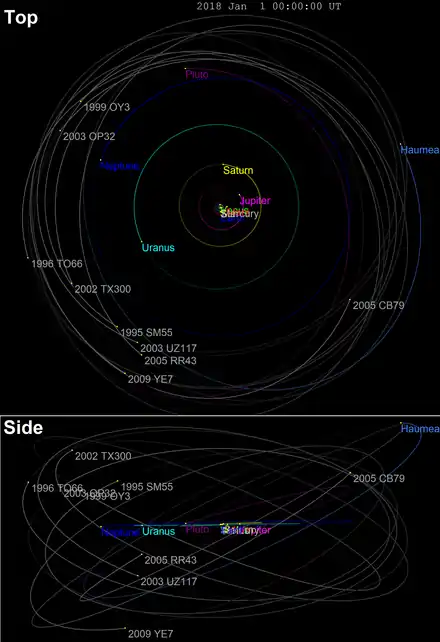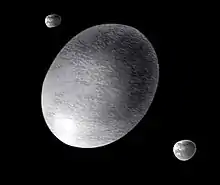(416400) 2003 UZ117
(416400) 2003 UZ117 is a trans-Neptunian object and suspected member of the Haumea family, located in the Kuiper belt in the outermost region of the Solar System. It was discovered on 24 October 2003, by astronomers of the Spacewatch survey project at Kitt Peak Observatory, Arizona.[4] The object may also be a non-resonant cubewano.[3]
 Hubble Space Telescope image of 2003 UZ117 taken in 2010 | |
| Discovery [1][2] | |
|---|---|
| Discovered by | Spacewatch |
| Discovery site | Kitt Peak National Obs. |
| Discovery date | 24 October 2003 |
| Designations | |
| (416400) 2003 UZ117 | |
| 2003 UZ117 | |
| TNO [1][2] · cubewano(?) [3] distant [4] · Haumea [5] Extended[6] | |
| Orbital characteristics [1] | |
| Epoch 4 September 2017 (JD 2458000.5) | |
| Uncertainty parameter 3 | |
| Observation arc | 13.23 yr (4,831 days) |
| Aphelion | 49.777 AU |
| Perihelion | 38.325 AU |
| 44.051 AU | |
| Eccentricity | 0.1300 |
| 292.38 yr (106,791 days) | |
| 339.93° | |
| 0° 0m 12.24s / day | |
| Inclination | 27.473° |
| 204.72° | |
| ≈ 20 November 2032[7] ±2 days | |
| 247.45° | |
| Physical characteristics | |
| Dimensions | 138 km[8] 371 km (derived)[9] 423 km[3] |
| 6 h (poor)[10] 10.61±0.02 h[11] | |
| 0.07 (derived)[8] 0.09 (assumed)[3] 0.1 (assumed)[9] | |
| BB [12] · C [9] | |
| 4.92±0.01 (R)[13] · 4.920±0.083 (R)[14] · 5.18±0.03[12] · 5.22[15] · 5.27[9] · 5.27±0.02[16] · 5.3[1] · 5.4[8] | |
Orbit and physical characterization

2003 UZ117 orbits the Sun at a distance of 38.3–49.8 AU once every 292 years and 5 months (semi-major axis of 44.05 AU). Its orbit has an eccentricity of 0.13 and an inclination of 27° with respect to the ecliptic.[1] Precovery images have been identified back to 2002.[4]
Estimates for its diameter range between 138 and 423 kilometers.[3][8][9] Two rotational lightcurves of the object gave a rotation period of 6 and 10.61 hours with a brightness amplitude of 0.1 and 0.09 in magnitude, respectively (U=1/2).[10][11] It has a spectral type of BB, with a grey/blue rather than red color.[12]
Origin
Based on their common pattern of infrared water-ice absorption and the clustering of their orbital elements, the other KBOs, it appear to be collisional fragments broken off the dwarf planet Haumea. The neutral color of the spectrum of these objects in the visible range evidences a lack of complex organics on the surface of these bodies that has been studied in detail for the surface of Haumea.[5]
See also
- List of Solar System objects most distant from the Sun in 2015
References
- "JPL Small-Body Database Browser: 416400 (2003 UZ117)" (2016-02-04 last obs.). Jet Propulsion Laboratory. Retrieved 9 December 2017.
- "List Of Transneptunian Objects". Minor Planet Center. Retrieved 9 December 2017.
- Johnston, Wm. Robert (15 October 2017). "List of Known Trans-Neptunian Objects". Johnston's Archive. Retrieved 9 December 2017.
- "416400 (2003 UZ117)". Minor Planet Center. Retrieved 9 December 2017.
- Pinilla-Alonso, N.; Brunetto, R.; Licandro, J.; Gil-Hutton, R.; Roush, T. L.; Strazzulla, G. (March 2009). "The surface of (136108) Haumea (2003 EL61), the largest carbon-depleted object in the trans-Neptunian belt". Astronomy and Astrophysics. 496 (2): 547–556. arXiv:0803.1080. Bibcode:2009A&A...496..547P. doi:10.1051/0004-6361/200809733. Retrieved 9 December 2017.
- Marc W. Buie. "Orbit Fit and Astrometric record for 416400". SwRI (Space Science Department). Retrieved 2018-02-18.
- JPL Horizons Observer Location: @sun (Perihelion occurs when deldot changes from negative to positive. Uncertainty in time of perihelion is 3-sigma.)
- Michael E. Brown. "How many dwarf planets are there in the outer solar system?". California Institute of Technology. Retrieved 9 December 2017.
- "LCDB Data for (416400)". Asteroid Lightcurve Database (LCDB). Retrieved 9 December 2017.
- Perna, Davide; Dotto, E.; Barucci, A.; Rossi, A.; de Bergh, C.; Doressoundiram, A.; et al. (September 2008). "Light Curves and Densities of Centaurs and Trans-Neptunian Objects from the ESO Large Program". American Astronomical Society. 40: 483. Bibcode:2008DPS....40.4708P. Retrieved 9 December 2017.
- Thirouin, Audrey; Sheppard, Scott S.; Noll, Keith S.; Moskovitz, Nicholas A.; Ortiz, Jose Luis; Doressoundiram, Alain (June 2016). "Rotational Properties of the Haumea Family Members and Candidates: Short-term Variability". The Astronomical Journal. 151 (6): 20. arXiv:1603.04406. Bibcode:2016AJ....151..148T. doi:10.3847/0004-6256/151/6/148. Retrieved 9 December 2017.
- Perna, D.; Barucci, M. A.; Fornasier, S.; DeMeo, F. E.; Alvarez-Candal, A.; Merlin, F.; et al. (February 2010). "Colors and taxonomy of Centaurs and trans-Neptunian objects". Astronomy and Astrophysics. 510. arXiv:0912.2621. Bibcode:2010A&A...510A..53P. doi:10.1051/0004-6361/200913654. Retrieved 9 December 2017.
- Jewitt, David; Peixinho, Nuno; Hsieh, Henry H. (November 2007). "U-Band Photometry of Kuiper Belt Objects". The Astronomical Journal. 134 (5): 2046–2053. Bibcode:2007AJ....134.2046J. doi:10.1086/522787. Retrieved 9 December 2017.
- Peixinho, N.; Delsanti, A.; Guilbert-Lepoutre, A.; Gafeira, R.; Lacerda, P. (October 2012). "The bimodal colors of Centaurs and small Kuiper belt objects". Astronomy and Astrophysics. 546: 12. arXiv:1206.3153. Bibcode:2012A&A...546A..86P. doi:10.1051/0004-6361/201219057. Retrieved 9 December 2017.
- Tegler, S. C.; Romanishin, W.; Consolmagno, G. J.; J., S. (December 2016). "Two Color Populations of Kuiper Belt and Centaur Objects and the Smaller Orbital Inclinations of Red Centaur Objects". The Astronomical Journal. 152 (6): 13. Bibcode:2016AJ....152..210T. doi:10.3847/0004-6256/152/6/210. Retrieved 9 December 2017.
- Boehnhardt, H.; Schulz, D.; Protopapa, S.; Gö; tz, C. (November 2014). "Photometry of Transneptunian Objects for the Herschel Key Program `TNOs are Cool'". Earth. 114 (1–2): 35–57. Bibcode:2014EM&P..114...35B. doi:10.1007/s11038-014-9450-x. Retrieved 9 December 2017.
External links
- Asteroid Lightcurve Database (LCDB), query form (info)
- Discovery Circumstances: Numbered Minor Planets (415001)-(420000) – Minor Planet Center
- (416400) 2003 UZ117 at the JPL Small-Body Database
